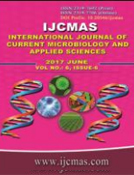


 National Academy of Agricultural Sciences (NAAS)
National Academy of Agricultural Sciences (NAAS)

|
PRINT ISSN : 2319-7692
Online ISSN : 2319-7706 Issues : 12 per year Publisher : Excellent Publishers Email : editorijcmas@gmail.com / submit@ijcmas.com Editor-in-chief: Dr.M.Prakash Index Copernicus ICV 2018: 95.39 NAAS RATING 2020: 5.38 |
Twenty Vibrio species were isolated from different sites along Alexandria sea shore. The phenotypic characterization, haemolytic activity and resistance pattern of the isolated Vibrio strains to different commercial antibiotics were investigated. All isolates showed varied results in the biochemical and physiological tests. Count Estimation of the associated vibriophages were carried out using the isolated Vibrio species (V1-V20) as host strains. The highest counts (1840 PFU/ml) was recorded on V17. Four morphologically distinct phages namely P10, P16, P17 and P20 were selected and tested for their host specificity to the isolated Vibrio strains. P17 showed the highest host specificity (55%). It showed DNA profile of 20 k bp. The present study looks to sensitivity of P17 toward temperature, pH and ultraviolet radiation. Results concluded that P17 was sensitive to heat and the most destructive temperature was 5oC with 100% reduction in the phage titre. The highest lytic activity of p17 was at pH7, lower activity was observed at pH lower or higher than pH7. UV affected phage survival after 2 sec exposure, however low lytic activity was observed up to exposure to UV for120 sec. Phage host interaction showed that P17 had burst size (100 PFU per cell) and latent period (10 min). P17 was tested for its potentiality as biocontrol agent of Vibrio sp. in the live feed Artemia salina. P17 showed promising lytic activity against Vibrio sp. invading A. salina and recorded 92% reduction in Vibrio load after 18 h, which can be applicable as ecofriendly bio control agent of pathogens in the aquaculture.
 |
 |
 |
 |
 |